Search Results
BART's 2023 Sustainability Report highlights agency's innovation and improvements to rider experience

BART continued in 2023 to pioneer sustainability initiatives aimed at enhancing rider experience while prioritizing environmental stewardship. With a legacy rooted in forward-thinking transportation solutions, BART reaffirmed its commitment to reducing carbon footprints and advancing sustainable transit practices. The accomplishments of 2023 are detailed in the annual Sustainability Report, officially presented to the Board of Directors on July 11, 2024.
"BART’s sustainability efforts were all about innovation in 2023," said BART Board President Bevan Dufty. "We are dedicated to integrating creative solutions that not only improve the rider experience, our immediate priority, but also emphasize long-term sustainability."
Established over fifty years ago with a vision to alleviate regional traffic congestion through eco-friendly transit options, BART has continually evolved its practices to reflect contemporary environmental standards. Notably, engineers initially opted to power trains with electricity rather than fuel, a decision that laid the foundation for ongoing sustainability achievements.

In a poignant farewell to its legacy fleet, BART hosted a memorable "retirement party" in February 2024, marking the culmination of efforts to retire older vehicles. Thousands of attendees gathered to bid farewell to the trains that had served millions of passengers over the years. The decommissioned cars are being repurposed for various projects, including a BART car short-term rental in the Sierra Nevada and a youth bike shop and clubhouse in East Oakland, demonstrating BART’s commitment to sustainability beyond transit operations.
The introduction of new, energy-efficient train cars has furthered BART's sustainability goals, boasting a 7% reduction in energy consumption compared to previous train car models. By running shorter trains during off-peak hours, BART has achieved significant energy savings. 88% of BART’s electricity comes from greenhouse gas-free sources like solar, wind, and hydropower.
"Our shorter trains not only save energy and reduce costs but also enhance safety and efficiency in maintenance," BART General Manager Bob Powers added. "These innovations underscore our holistic approach to sustainability across all facets of our operations."
In addition to transit improvements, BART expanded its Transit-Oriented Development (TOD) program, constructing 531 new housing units near BART stations. Projects like the Gateway at Millbrae Station and the Upper Yard at Balboa Park Station not only address regional housing needs but also promote sustainable urban development and economic revitalization.
Highlighting unique environmental initiatives, BART's Sheep and Goat Fire Mitigation program has grown substantially, utilizing over 500 grazers to mitigate fire risks across its properties. Meanwhile, the Falconry-Based Nuisance Bird Control program, now implemented at 12 stations, effectively manages pigeon populations through pesticide-free methods.
For more information on BART's sustainability initiatives and ongoing projects, visit bart.gov/sustainability.
BART to offer more service than ever before for SF Pride 2024
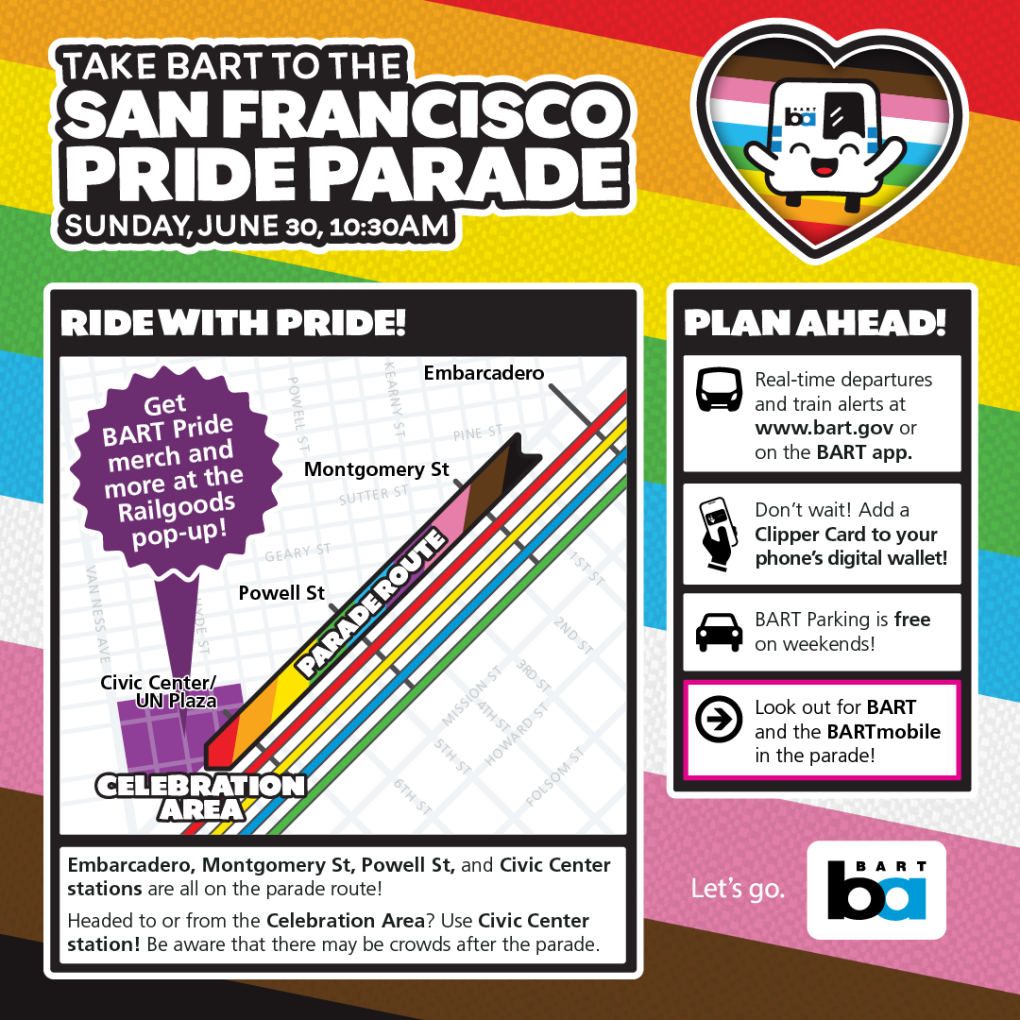
BART will offer its most robust service ever for the annual San Francisco Pride Parade. The parade will be held on Sunday, June 30, beginning at 10:30am, along Downtown San Francisco’s Market Street.
We encourage you to take BART and “ride with Pride” to get to and from the parade safely and expediently. Embarcadero, Montgomery St, Powell St, and Civic Center stations are all along the parade route (see rider guide).
BART will open at 8am and run 5-line service with trains every 5 minutes through Downtown San Francisco. Additional event trains will be dispatched as ridership warrants. After 9pm, BART will run 3-line service.
In the morning, event trains will bolster our service between Millbrae and Downtown San Francisco as well as between Pleasant Hill and Downtown San Francisco from 9:30 to 11am. Later in the day, event trains will start at 2pm in and continue into the evening, supplementing scheduled service.
The parade begins at 10:30am at Market and Beale streets, closest to Embarcadero Station. It will end at Market and 8th streets, closest to Civic Center Station.
Riders should expect large crowds at Embarcadero Station before 10am and large crowds all day at Civic Center Station, as well as heavy ridership to and from all Downtown San Francisco stations and 16th St Mission Station. Riders are encouraged to use Montgomery St and Powell St instead of Civic Center or Embarcadero stations.
Last year, BART handled 140,006 trips as riders took advantage of expanded Sunday service. That's about 6,000 more riders than took BART for Pride 2022 and 117% of pre-COVID ridership projections for a June Sunday. At the time, it was BART's busiest Sunday since the start of the pandemic.
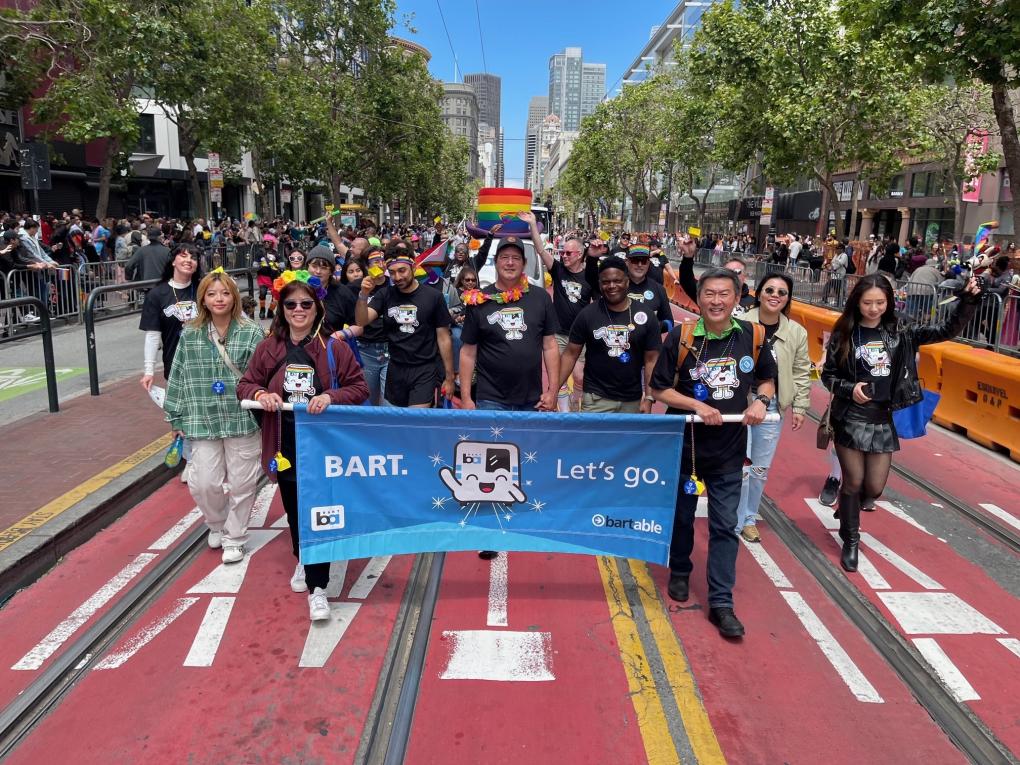
Tips for taking BART to the SF Pride Parade and Celebration
- Before you leave home put a Clipper card on your cellphone through either Apple Pay or Google Pay. There is no $3 new-card fee for riders who add either of the mobile options. Please ensure you have sufficient funds for a round trip.
- Embarcadero, Montgomery Street, Powell Street and Civic Center stations can all be used to get to the parade route.
- Download the official BART app to plan your trip, get real-time departures, and pay for parking.
- Be patient. It could get crowded on trains and in our stations. BART’s busiest hours are expected to be from the parade start until 2pm and from 4 pm to 8 pm leaving the parade and celebration.
- When boarding trains, move to the center of the car so more people can fit and remove backpacks.
- Don’t jam a train door, which can take the whole train out of service.
Getting to BART/Parking
Consider taking a bus, getting dropped off, riding your bicycle, or walking to your station.
BART offers free parking on weekends, except at Milpitas and Berryessa/North San Jose stations, which are owned by VTA and VTA's parking rates still apply. More info on parking at BART: bart.gov/parking.
BART in the parade + booth at Civic Center Celebration
BART staff, their families, and friends will march in the San Francisco Pride Parade with the BARTmobile and a specialized Hi-Rail vehicle that is typically used to transport BART workers around the system when trains are not running.
BART will also have a presence at the Civic Center Celebration in Civic Center/UN Plaza (served by Civic Center Station) on Sunday, June 30, ONLY. We will no longer be at the celebration on Saturday.
On Sunday, Railgoods will sell BART merch, including new Pride 2024 items, at the booth. Pick up your swag in person and skip the shipping fees!
Have a safe and happy Pride!
San Francisco Pride is the largest annual gathering of LGBTQ+ people and allies in the nation and has come to symbolize the long history of LGBTQ+ dignity, the freedom of all people to meaningfully and proudly express their sexual and gender identities, and the commitment of LGBTQ+ people to combating oppression.
BART wishes everyone attending a safe and happy celebration.
BART board approves new financial organizational structure recommended by Inspector General
BART is moving forward with changes to its financial operations to improve efficiency and transparency with the creation of a Chief Financial Officer (CFO) reporting to the General Manager.
This new financial structure brings together the functions from the Office of the Controller-Treasurer, who has traditionally reported to the BART Board of Directors, and the Performance & Budget Office, who reports to the General Manager, into one group, reporting to a new CFO position.
The CFO will have the authority to implement strategic business changes to streamline BART’s financial forecasting, budgeting, and reporting of financial data. The new structure will create greater accountability under the General Manager to realize long-term cost savings. Creating a CFO position requires state legislation to amend the BART Act.
“This is a significant reform to show we are committed to using our limited financial resources in the most efficient manner possible,” said BART Board President Janice Li. “A new CFO will help drive a culture of financial discipline as we navigate economic uncertainty.”
Last year, the Board of Directors, at the recommendation of the Office of the Inspector General, approved modifying BART’s organizational structure in an effort to focus on improving efficiency and financial operations.
“This is a tremendous step for BART and reflects how well the OIG recommendation for a CFO structure was embraced,” said Claudette Biemeret, BART’s Inspector General. “I applaud the BART Board and Executive Leadership for taking on this change. CFO leadership is crucial to transparency and accountability in the use of public funds.”
In response, BART’s General Manager hired a consulting team to develop a roadmap for implementing the financial organization structure. The BART Board of Directors approved the new structure at its December 7 meeting and BART will move quickly to identify and onboard a new CFO role.
Disability Pride Month: Harold Willson's fight to make BART accessible for all
Last week, Governor Gavin Newsom proclaimed July as Disability Pride Month. The month marks the anniversary of the Americans with Disabilities Act (ADA) that was signed into law on July 26, 1990. The ADA was a major milestone for civil rights in the U.S. that "prohibits discrimination against individuals with disabilities in all areas of public life, removing barriers to employment, transportation, public services and other critical areas," per Newsom's proclamation.
More than 7% of BART riders have a disability, and BART is continuously working to make the system as easy to use as possible for every single person who rides and relies on us. Our work is ongoing.
This month, BART will be celebrating riders with disabilities and the contributions they have made to our transportation system and region.
We begin with the story of Harold Willson, originally published in 2022.
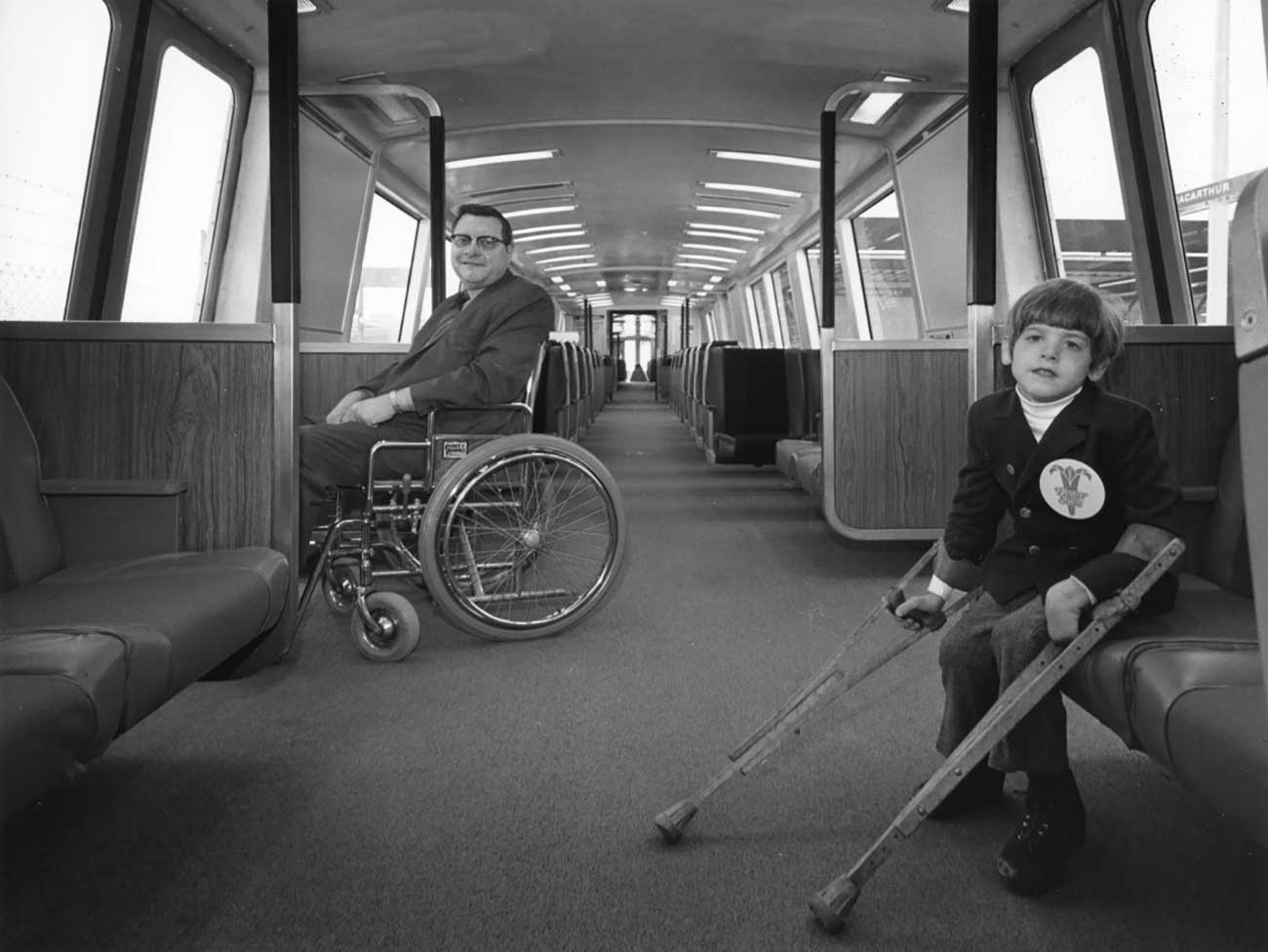
Harold Willson (left) smiles at Eric Staley (right) on a BART train in 1972. Photo courtesy of Kaiser Permanente Heritage Resources.
“There is a special personal pride in being the first handicapped person in a wheelchair to use a subway train, and to represent all handicapped travelers who will use the BART system in years to come. I’ll never forget that sense of freedom I experienced as I boarded the BART train.”
– Harold Willson, quoted in “Accent on Living,” Spring 1973
When Harold Willson was 21 years old, his life forever changed.
The West Virginia native dropped out of university when his funds ran out and started working as a coal miner. On a regular day in February 1948, about two years after he began working in the mines, Willson was caught in a slate fall. He suffered severe spinal damage, broken ribs, and a broken back.
Willson’s tragic accident spurred a lifetime of advocacy. His work to raise awareness and secure rights and access continues to impact the freedom and mobility of transit riders across the nation. Thanks to Willson’s efforts in the 1960s, BART became the first public transit system in the nation with accessible trains and stations.
“Never again would skeptics be able to argue that trains could not be made wheelchair accessible" after Willson, write Doriz Zames Fleischer and Frieda Zames in “The Disability Rights Movement."
Four months after his accident, Willson was transferred by train to the Kaiser Foundation Rehabilitation Center in Vallejo. It was a felicitous move, one that would forever alter the course of his life and public transportation. In his two years at the facility, Willson underwent intensive physical therapy and multiple surgeries. Doctors told the young man he would use a wheelchair for the rest of his life.
In 1950, Willson joined Bank of America and married Patricia Leister, who was a member of the nursing staff that treated him at Kaiser. Six years later, he completed a degree in business administration at Golden Gate College, and a year after that, he was hired as an accountant at the Kaiser Foundation Medical Care Program. Willson would go on to hold a variety of positions at Kaiser throughout his life. He’d retire as a senior financial analyst for the Kaiser Foundation Health Plan in 1977.
Said Cuong Le, historian for the nonprofit health care provider: "Kaiser Permanente is fortunate to have passionate and influential employees like Harold Willson, whose remarkable success advocating for historically overlooked needs of people with disabilities led to substantially improved conditions."
During the years that Willson lived in the Bay Area, the region was aflutter with the news of a soon-to-be-constructed rapid transit system that would connect the Bay. The tenor of excitement shifted for Willson when he learned the system, to be called the San Francisco Bay Area Rapid Transit District, or BART for short, would not be accessible for people with disabilities. Four percent of the Bay Area population at the time had severely limited mobility, meaning the BART system would exclude them from its ridership.
“When the system was built in the 60s, the elevators weren’t a consideration,” said Bob Franklin, BART’s Director of Customer Access and Accessibility. “They were completely an afterthought.”
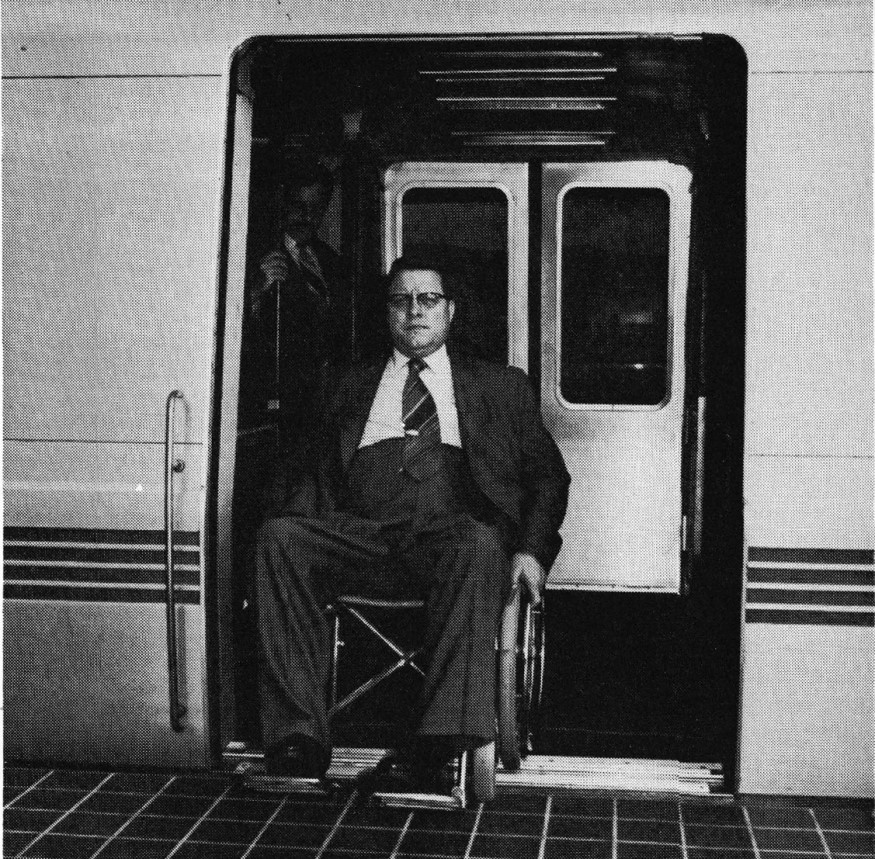
Photo courtesy of Kaiser Permanente Heritage Resources.
Willson reached out to BART and offered his services as a “volunteer consultant” to the BART Board starting in 1964. He had a unique and compassionate approach to advocacy, according to the people who knew and worked with him.
“His suggestion was novel for rapid transit, no one had tried it,” A.E. Wolf, the General Superintendent of Transportation for BART, is quoted as saying in the Spring 1973 issue of “Accent on Living." “It posed all kinds of problems; cost was significant. Our staff, including myself, was hardly enthusiastic.”
“But, he did not threaten, nor picket, nor sulk, nor lose patience,” Wolf continued. “Instead, he was professional, pleasant, firm and persistent. As a result, he won the support of each of our board members while maintaining a friendly relationship with our staff.”
Willson’s approach was to “sell” the idea for an accessible BART system by contacting people one by one and having individual conversations with them, slowly winning them over to his cause.
“You could be a pioneer in being the first major public transportation system to be accessible to the handicapped,” Willson told the BART Board and staff in 1963, according to Michael Healy’s “BART: The Dramatic History of the Bay Area Rapid Transit System.”
Willson’s methods worked. In 1968, the BART Board requested $7 million from the California legislature to include accessible elevators in its plans (the figure was later revised to $10 million).
Willson’s advocacy did not stop there. He and representatives from BART continued to lobby Sacramento until $150 million in additional funding for wheelchair accessibility was allocated to the under-construction system in March 1969. BART, with Willson's guidance and persistence, was ahead of its time. It would be more than two decades later that the Americans with Disabilities Act (ADA) was signed into law.
Among the accommodations the funding secured were elevators at every station, telephones in elevators and stations that were accessible for wheelchair users, special service gates and handrails, Braille symbols on elevator door casings, loudspeaker directions for those who are low vision and blind, closed-circuit televisions as needed, and level boarding between the platform and train.
In the years since Willson’s advocacy, BART has added even more accessible features to the system, which you can read about on bart.gov/guide/accessibility.
After BART was built, Willson would go on to continue advocating for accessibility. In 1971, Willson and Wilmot R. McCutchen, Chief of Design for BART, testified before a special U.S. Senate Committee on Aging. Their testimony was “an important precursor to raising public consciousness of the issue of disabled access,” writes Healy in his "BART" book. A robust disability rights and independent living movement would emerge in the years that followed Willson's lobbying.
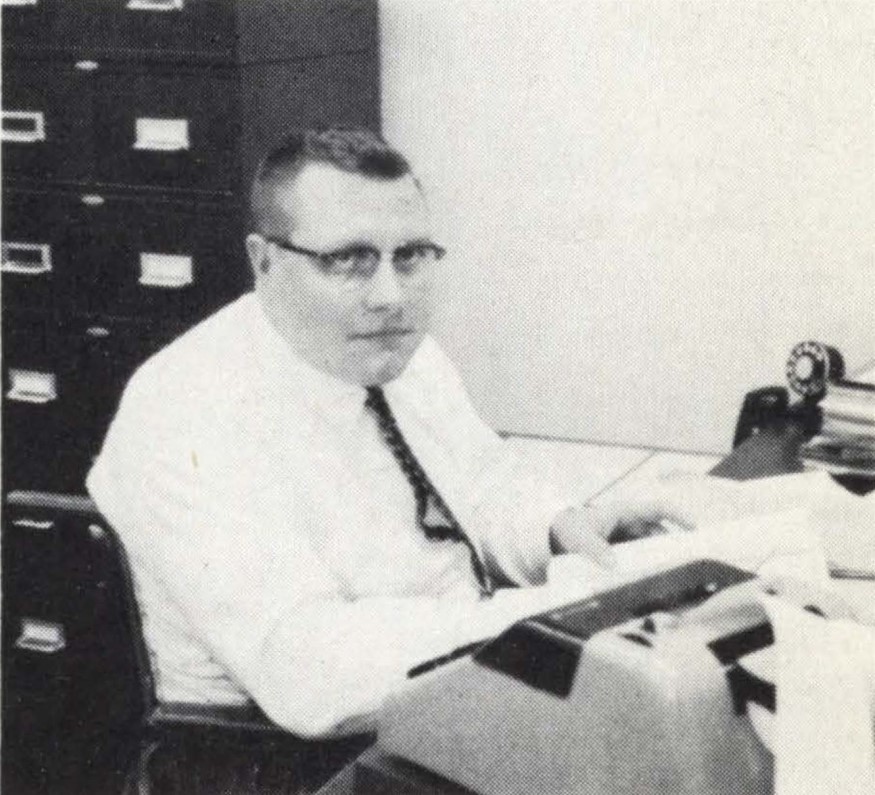
Image courtesy of Kaiser Permanente Heritage Resources.
Willson died in the Bay Area in 1994.
His legacy continues to reverberate across the nation. After BART, the newly built transit systems WMATA and MARTA also made their systems accessible, setting a new precedent for future generations of public transit.
“All of this is possible because one man had a bright shiny dream, and he made it come true,” Wolf is quoted as saying in a 2008 journal.
Denise Figueroa, the Executive Director of the Independent Living Center of the Hudson Valley and a longtime transit advocate, noted that transit has “come a very long way in terms of accessibility” from the 1950s and 1960s.
“In those days, when Willson first started out, there wasn’t an expectation of accessibility,” she said by phone. “Over the years, what has changed is that the public expects transit to be accessible – even non-disabled people.”
Figueroa said the mentality of transit systems was often, “It’s not my problem.” She said agencies would routinely cite cost as the prohibiting factor.
“The argument was always: It’s too expensive,” she said. That changed with the passage of ADA (1990), as well as Section 504 of the Rehabilitation Act (1973), which requires public entities that receive federal funding to ensure that people with disabilities are not discriminated against, nor denied goods or services.
Today, BART continues to bolster its efforts to make the system accessible for all riders. The transit agency hosts a monthly BART Accessibility Task Force on the fourth Thursday of each month, where the public can voice concerns, ask questions, and provide input. BART, which is ADA accessible by law, also encourages passengers to make a Reasonable Modification Request if their needs are not being met.
When transit systems are accessible for all, said Franklin in closing, everybody wins.
“It’s a federal law now that we’re accessible to everyone,” he said. “And when we design it that way, everyone benefits. The more universally we can design something, the better it will be.”
The BART Accessibility Task Force (BATF) is actively recruiting new members. If you are interested or have questions, please contact, Elena Van Loo, Customer Access and Accessibility Department, by phone at (510) 874-7366 or by e-mail at [email protected].
BART to run round-the-clock during Labor Day weekend Bay Bridge closure
BART will be open while the Bay Bridge is closed over Labor Day Weekend. BART will run trains on a 24 hour basis beginning the night of Wednesday, August 28th until the night of Monday, September 2nd. BART resumes normal weekday service at about 4 am on Tuesday, September 3rd. The overnight trains will
Multi-agency law enforcement training at four BART stations, Tuesday 1/28/14
THIS EVENT HAS BEEN POSTPONED. New event information will be posted as soon as it is rescheduled. From 8:30am to 12:30pm on Tuesday, January 28, BART Police, the Transportation Security Administration (TSA), and Bay Area law enforcement will be working with other local transit agencies to conduct joint
BART PD’s Progressive Policing Bureau wins prestigious national award for innovation
The BART Police Department’s Progressive Policing and Community Engagement Bureau has won the American Public Transportation Association’s national Innovation Award. The Progressive Policing and Community Engagement Bureau (PPCEB) has established itself as a national model by increasing BART’s safety presence while ensuring the system is welcoming to all members of the community. The PPCEB is a trail blazing part of the effort to ensure BART is the safest way to travel across the Bay Area.
“The members of the Progressive Policing and Community Engagement Bureau are force multipliers for rider safety,” said BART PD interim Chief Kevin Franklin. “The bureau has become a national model with both transit and traditional law enforcement agencies reaching out to us to learn more about the innovative steps we’re taking to boost safety for our riders.”
The numbers show how the PPCEB is boosting rider safety. In the first six months of this year members of the PPCEB performed more than 10,700 welfare checks on people in the BART system who appeared to need help. There were more than 2,500 instances when PPCEB members intervened when they saw violations of BART’s Code of Conduct. In the past those violations would have required a response by a sworn officer. Instead, members of the PPCEB can offer a more appropriate response with unarmed, specially trained BART PD staff. That has freed up sworn officers to respond more quickly to urgent emergency calls. BART PD has one of the fastest response times for tier 1 emergency calls at an average of just more than 4 minutes.
The PPCEB is primarily composed of non-sworn Transit Ambassadors and Crisis Intervention Specialists. These unarmed employees of BART PD receive specialized training in de-escalation techniques. Transit Ambassadors walk dozens of trains and platforms each day. They’re equipped with radios to report safety concerns. They observe, report, and call upon traditional sworn officers when enforcement is needed. Crisis Intervention Specialists have backgrounds in social work and specialize in connecting people at risk with potentially lifesaving services.
The PPCEB was launched in 2020. It was the first of its kind for a transit agency in the U.S. The BART PD model stands out because members of the PPCEB are full-time BART PD employees as opposed to contractors that many other systems rely on. The bureau builds on a history of more than a decade of reform efforts aimed at elevating equitable policing at BART.
BART to Antioch train times to shift beginning March 24, to improve transfer
Beginning Monday, March 24, 2025, BART to Antioch train times will shift by several minutes to improve the connection with BART at the transfer platform in Pittsburg.
We are lengthening the window of time for the regular BART train to connect to the BART to Antioch DMU train to improve the reliability of the transfer. While this will lengthen the total time for trips that include BART to Antioch service, it will significantly cut down on the number of missed transfers, which is currently causing even longer delays for Antioch riders.
This change means departure and arrival times at Antioch and Pittsburg Center stations are shifting by six or seven minutes depending on the direction of travel. We encourage Antioch and Pittsburg Center riders to look up the new train times before the change goes into effect.
Trips from Antioch and Pittsburg Center toward SFO will leave seven minutes earlier than before. Trips from SFO towards Pittsburg Center and Antioch will arrive six minutes later.
For riders who rely on clock-face schedules, here is an example of the change:
- For the current schedule, trips at Antioch Station start on the 10/30/50 minutes after the hour and trips at Pittsburg Center start on the 17/37/57 minutes after the hour.
- For the new schedule, trips at Antioch Station start on the 03/23/43 minutes after the hour (except for the first three trains of the day) and trips at Pittsburg Center start on the 10/30/50 minutes after the hour.
The times for regular BART trains on the Yellow Line (Pittsburg/Bay Point to SFO) are unchanged.
View the Yellow Line PDF timetable for weekday service.
View the Yellow Line PDF timetable for weekend service.
The Trip Planner is in the process of being updated, and riders will be able to see their new itineraries by selecting the date of March 24, 2025, and beyond.
“Making this transfer at Pittsburg work for our riders is very important to us,” said BART Board President Mark Foley, who represents BART to Antioch riders. “It is frustrating to riders when they must wait on the transfer platform with little information. The current schedule has too narrow of a window for the regular BART trains and the BART to Antioch DMU trains to line up. This change will improve the transfer. BART to Antioch riders have some of the longest and most expensive commutes, and I am grateful to the BART team for quickly making changes to prioritize this transfer and East Contra Costa County riders.”
BART will begin to size trains for safety and efficiency starting September 11, 2023
When BART’s reimagined schedule launches September 11, 2023, BART will begin to shorten the length of its least crowded trains to improve safety, allow for a cleaner fleet of cars, and maximize BART’s scarce resources. The adjustment of train lengths is consistent with our top priority of ensuring BART is the safest way to travel around the Bay Area.
Shorter trains mean:
• More police and safety staff presence
• Cleaner trains
• Only new trains will be in service unless there is a need to run an old train
• Fewer delays because new cars have double the reliability rate of old cars and we will have more standby trains available
• $12 million is cost savings
BART will still run long trains during special events.
While BART plans to run shorter trains, we will remain very nimble and monitor crowded data on an hourly basis. Our commitment is to quickly add additional cars to trains if there is a high level of crowding, especially during peak commute hours. While we plan to launch this effort using 8-car and 6-car trains, we will quickly adjust as ridership grows.
Running trains with fewer cars will allow the BART Police Department to increase its visibility on trains and platforms while using the same number of staff. When there’s a call for service, officers can clear shorter trains much more quickly. Officers on train patrols will also be able to walk more of the in-service train cars.
“There is safety in numbers and that’s especially true on BART,” said BART PD interim Chief Kevin Franklin. “This change will allow us to have more eyes on train car as we continue to boost our visible safety presence with our officers and unarmed Transit Ambassadors and Crisis Intervention Specialists. A lot of unwanted behavior will be deterred through the presence of more riders and potential witnesses in every train car.”
Shortening trains allows BART to run only Fleet of the Future trains for its base schedule. Legacy trains will still be used if they are needed during large events or if they are needed to replace a new train, but this move accelerates the retirement of the old fleet.
Sizing trains for safety is a direct response to feedback gathered through the Not One More Girl anti-harassment initiative. Eliminating empty and near-empty trains cars will create a safer, more welcoming environment for women, girls, gender non-conforming people, seniors, families, and all riders. BART encourages people concerned about safety to ride in the first car closest to the Train Operator. These changes have the effect of bringing the first car closer to all riders. Courtesy announcements will be increased about priority seating, removing backpacks, and no bikes on crowded cars.
BART will realize cost savings and efficiency gains through this change. BART is expected to save about $12 million annually through reduced power consumption and cars logging fewer operating hours. It will improve operational flexibility and cleaning crews will have fewer cars to focus on at end of the line stations.
“We want to show the entire region that we’re trying new things with safety in mind,” said Alicia Trost, Chief Communications Officer. “This is a change that will enhance safety and cleanliness while also saving money during our financial crisis without cutting service.”